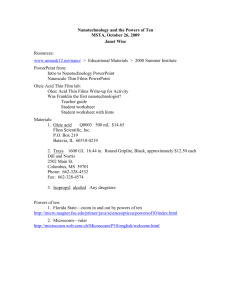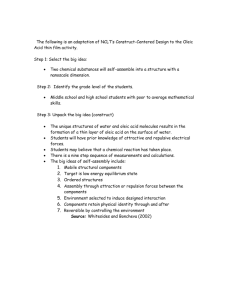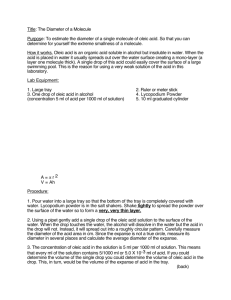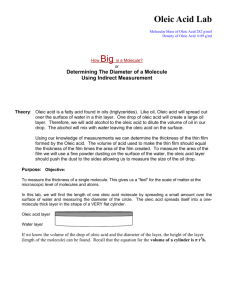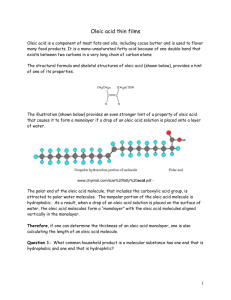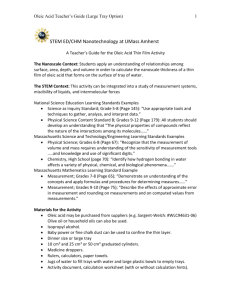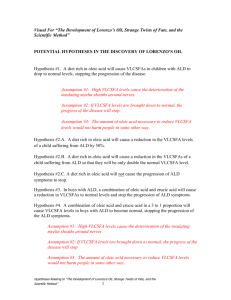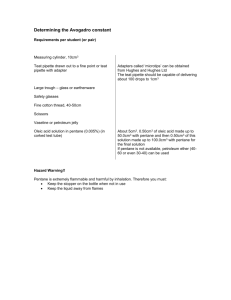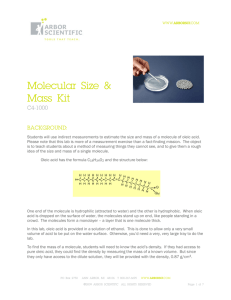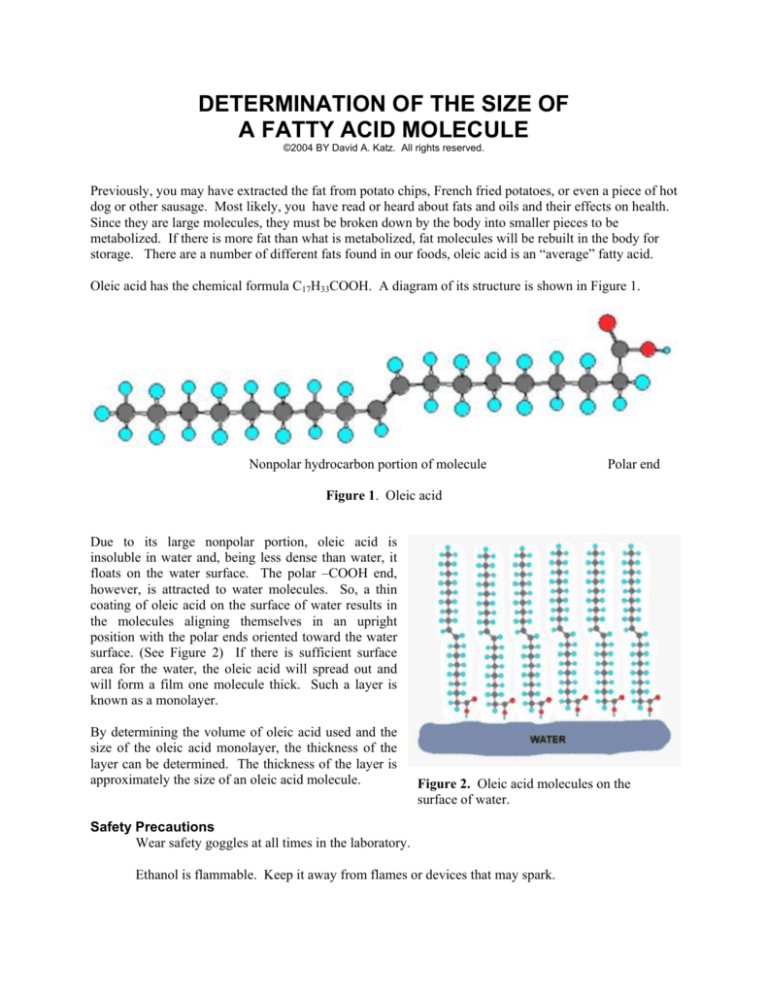
DETERMINATION OF THE SIZE OF
A FATTY ACID MOLECULE
©2004 BY David A. Katz. All rights reserved.
Previously, you may have extracted the fat from potato chips, French fried potatoes, or even a piece of hot
dog or other sausage. Most likely, you have read or heard about fats and oils and their effects on health.
Since they are large molecules, they must be broken down by the body into smaller pieces to be
metabolized. If there is more fat than what is metabolized, fat molecules will be rebuilt in the body for
storage. There are a number of different fats found in our foods, oleic acid is an “average” fatty acid.
Oleic acid has the chemical formula C17H33COOH. A diagram of its structure is shown in Figure 1.
Nonpolar hydrocarbon portion of molecule
Polar end
Figure 1. Oleic acid
Due to its large nonpolar portion, oleic acid is
insoluble in water and, being less dense than water, it
floats on the water surface. The polar –COOH end,
however, is attracted to water molecules. So, a thin
coating of oleic acid on the surface of water results in
the molecules aligning themselves in an upright
position with the polar ends oriented toward the water
surface. (See Figure 2) If there is sufficient surface
area for the water, the oleic acid will spread out and
will form a film one molecule thick. Such a layer is
known as a monolayer.
By determining the volume of oleic acid used and the
size of the oleic acid monolayer, the thickness of the
layer can be determined. The thickness of the layer is
approximately the size of an oleic acid molecule.
Figure 2. Oleic acid molecules on the
surface of water.
Safety Precautions
Wear safety goggles at all times in the laboratory.
Ethanol is flammable. Keep it away from flames or devices that may spark.
Allergy alert: Lycopodium powder is the spores of club moss. If you have severe allergic
reactions to plant spores, please inform your instructor.
Disposal
Dispose of all waste material in the proper waste containers.
Materials Needed
Oleic acid solution in ethanol. This is a 1/200 solution by volume, prepared by dissolving 1 mL
oleic acid in 199 mL ethanol.
Lycopodium powder, place in salt or pepper shakers, if available.
Graduated cylinder, 10 mL
Beaker, 10 or 20 mL
Tray or baking pan: metal, glass, or aluminum foil, at least 9 inches (23 cm) in diameter.
Thin stem dropper
Ruler, 12 inch (30 cm)
Procedure
Obtain a small amount, approximately 3 mL of oleic acid solution in a small beaker.
Using a thin stem dropper and a 10 mL graduated cylinder, measure the number of drops of the oleic acid
solution in 1.0 mL. Record the number of drops. Do not empty the graduated cylinder. Repeat the
procedure by counting the number of drops in another 1.0 mL of the oleic acid solution. (You will now
have a total of 2.0 mL of liquid in the graduated cylinder.)
Obtain a tray or baking pan. Fill it approximately ½ with tap water. Place it on your lab bench where you
will be able to work with it, but not bump it or cause it to be agitated.
Once the water in the tray is very still, sprinkle a thin layer of lycopodium powder over the water. You
will need enough to cover the surface with no clumps of powder.
Add 1 drop of the oleic acid solution to the center of the tray.
After the drop has spread, and is stable for about 1 minute, measure the diameter of the oil spot in the
lycopodium powder. Record your measurement.
Dispose of the liquid in the tray or baking pan. Refill it with water, and repeat the process of adding the
lycopodium powder followed by the 1 drop of oleic acid solution, and measure the diameter of the oil
spot.
Dispose of the liquid in the tray or baking pan.
Clean up any oleic acid residue with soapy water.
Calculations (You may complete your calculations in the spaces provided below.)
Volume of 1 drop of oleic acid solution =
Volume of oleic acid in 1 drop of solution =
Area of oleic acid spot =
1.0 mL
Average number of drops in 1.0 mL
Volume of 1 drop of oleic acid solution
200
π (Average diameter of oleic acid spot) 2
Thickness of oleic acid spot =
4
Volume of oleic acid in 1 drop of solution
Area of oleic acid spot
Conversion factor: 1 nm = 1 x 10-7 cm
DETERMINATION OF THE SIZE OF
A FATTY ACID MOLECULE
Data and Results
Name _______________________________________________ Course and Section _______________
Partner ____________________________________________________ Date _____________________
Data and Calculations
Trial 1
Trial 2
Number of drops of oleic acid in 1.0 mL
________________
________________
Diameter of oleic acid spot
________________ cm
________________ cm
Average number of drops in 1.0 mL
___________________
Average diameter of oleic acid spot
___________________ cm
Volume of 1 drop of oleic acid solution
___________________ cm3
Volume of oleic acid in 1 drop of solution
___________________ cm3
Area of oleic acid spot
___________________ cm2
Thickness of oleic acid spot
___________________ cm
Length of an oleic acid molecule
___________________ nm
Questions
1. Why is the oleic acid diluted in the solution used in this experiment?
2. What is the purpose of the lycopodium powder?
3. How large is an oleic acid molecule as compared to a water molecule? (Find the size of a water
molecule in an Internet search. List your reference.)

